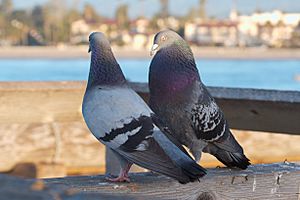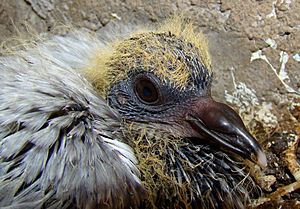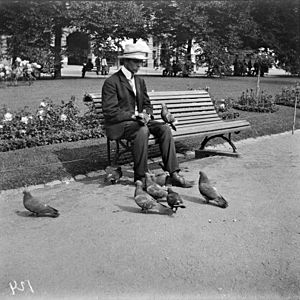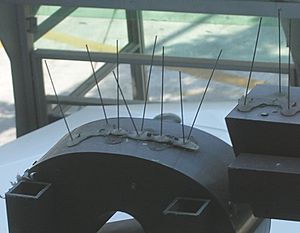Feral pigeon facts for kids
Quick facts for kids Columba livia domestica |
|
|---|---|
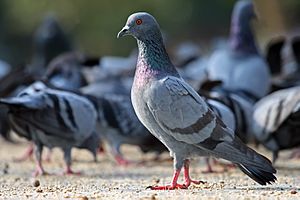 |
|
| Feeding in a park | |
| Conservation status | |
| Scientific classification |
|
| Kingdom: | Animalia |
| Phylum: | Chordata |
| Class: | Aves |
| Order: | Columbiformes |
| Family: | Columbidae |
| Genus: | Columba |
| Species: | |
| Subspecies: |
C. l. domestica
|
| Trinomial name | |
| Columba livia domestica Gmelin, 1789
|
|
| Synonyms | |
|
|
Feral pigeons (Columba livia domestica), also known as city doves or street pigeons, are pigeons that used to be pets but now live in the wild. They are descendants of domestic pigeons. These domestic pigeons were originally bred from wild rock doves, which naturally live on sea-cliffs and mountains. Wild, pet, and feral pigeons are all the same species. They can easily have babies together. Feral pigeons have learned to live in cities. They use building ledges like their wild relatives use cliffs. You can find many of them in towns and cities all over the world.
Because they make a lot of droppings and can sometimes carry diseases, pigeons are often seen as a nuisance. They are also considered an invasive species. Many cities try to control their numbers or even get rid of them.
Contents
What Feral Pigeons Look Like
Feral pigeons are about the same size and shape as the original wild rock dove. However, they come in many more colors and patterns than their wild ancestors. The blue-barred pattern, common in wild rock doves, is less common in city pigeons. Pigeons in cities often have darker feathers than those in the countryside.
Pigeon feathers have two types of color pigments called melanin. These are eumelanin and pheomelanin. Eumelanin usually makes grey or black colors. Pheomelanin creates reddish-brown colors. Different mixes of these pigments create other shades of brown. White pigeons have very little or no pigment. Darker birds might be better at storing tiny bits of metal in their feathers. This is because their feathers have more melanin. This might help them deal with metals, which are often found in higher amounts in cities.
Pigeon Reproduction and Life Cycle
How Pigeons Mate
Wild, pet, and feral pigeons usually stay with the same mate for life. However, these long-term pairs can sometimes break up. They are socially monogamous, meaning they mostly stick to one partner. But sometimes, males will mate with other females. Pigeons can produce a special "crop milk" to feed their young. This means they can breed at any time of the year.
Pigeon Courtship Rituals
You can see pigeons courting in city parks all year round. The male pigeon will puff up the feathers on his neck. This makes him look bigger to impress the female. He walks quickly towards her, making quiet, repeated sounds. He often bows and turns as he gets closer.
At first, the female usually walks or flies away a short distance. The male follows her until she stops. Then, he keeps bowing. He often does full or half-turns in front of her. After this, the male will feed the female. He brings up food from his stomach, just like he would feed his babies.
Then, the male gets on the female's back. He leans backward to join their cloacas (their reproductive openings). Mating is very quick. The male flaps his wings to stay balanced on top of the female.
Where Pigeons Build Nests
Abandoned buildings are favorite places for pigeons to nest. Many pigeons often nest together because they are flocking birds. Dozens of birds might share one building. Loose tiles and broken windows help them get inside. Pigeons are good at finding new ways in, especially after storms damage buildings.
Nests and droppings tend to stay together and dry when they are out of the weather. Pigeons especially like roof spaces. These often have water tanks. Any water tank on a roof needs to be sealed off to keep pigeons out. The number of pigeons in an area does not seem to affect how popular a nesting spot is.
On buildings that are not damaged, pigeons use gutters, window air conditioners, empty air conditioner boxes, chimneys, and outside ledges for nesting. Many building owners try to stop pigeons from roosting. They use bird control spikes and netting to cover ledges. This does not change the total pigeon population much. However, it can reduce the amount of droppings on a specific building.
In the UK, only the larger common wood pigeon builds nests in trees. These are usually close to roads. Wood pigeons often share the same areas and food as feral pigeons.
Pigeon Sounds: Cooing
Pigeons make cooing sounds. Males often coo when they are showing off or fighting. Female pigeons also coo, but their sound is less deep than the male's. Cooing is also more common between pairs during mating and nesting. Both parent pigeons help to incubate (sit on) the eggs.
What Pigeons Eat
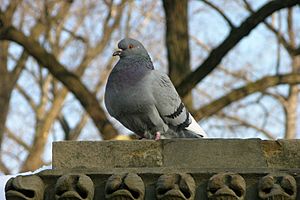
Pigeons breed when there is enough food to support their eggs. In cities, this can be any time of the year. They can lay eggs up to six times a year.
Pigeons are often seen in pairs during breeding season. But usually, they live in flocks of 50 to 500 birds. The size of the flock depends on how much food is available.
Feral pigeons eat grass seeds and berries in parks and gardens in the spring. But they find plenty of food all year round by scavenging. They eat leftover food from dropped fast food cartons. They also eat insects and spiders. More food often comes from trash bins. Tourists or residents also feed pigeons bird seed. They do this for many reasons, like kindness, fun, or tradition. Pigeons tend to gather in large groups when eating discarded food. They can fly very skillfully around trees, buildings, and even through moving traffic to reach food.
Pigeon Protection Status
In the U.K., pigeons are covered by "General Licences." This means landowners can humanely remove them for reasons like protecting crops. It is against the law to kill pigeons or destroy their nests for any other reason.
In the U.S., the Migratory Bird Treaty Act of 1918 protects native birds. But it does not protect feral pigeons, common starlings, or house sparrows. This is because these birds were brought to the U.S. from other places. It is usually legal to kill feral pigeons in the U.S. However, methods like poisons might have rules about how they can be used.
In India, pigeons are protected under specific laws. Wild pigeons have even more protection under the Wildlife Protection Act, 1972.
Famous City Squares with Pigeons
Many city squares are famous for having large pigeon populations. Some examples include Washington Square Park in New York City, George Square in Glasgow, the Piazza San Marco in Venice, and Dam Square in Amsterdam. The Gateway of India and Kabutarkhana in Mumbai also have many pigeons. Before 2000, Trafalgar Square in London was also known for its pigeons.
Controlling Pigeon Populations
Feral pigeons often have small populations within cities. For example, in Sheffield, England, there were only about 12,130 breeding pigeons. However, pigeons are most common in the central parts of cities. This means people see them often, which can lead to problems.
Do Pigeons Cause Health Risks?
Feral pigeons are often seen as pests. They are known to carry and spread diseases to humans and farm animals. However, it is rare for a pigeon to pass a disease to humans. This is because of their immune system. Even for people who work closely with pigeon nesting sites, the risk of getting sick is very low.
Studies have shown that pigeons do not carry the dangerous H5N1 strain of bird flu. Researchers even gave pigeons very high amounts of the virus. But they could not infect the pigeons. This was good news.
However, pigeons can transmit other germs. For example, a bacteria called Chlamydophila psittaci is common among pigeons. It causes a disease called psittacosis in humans. People usually get it from handling pigeons or their droppings. Psittacosis is a serious disease, but it is rarely deadly. Pigeons can also carry different types of Salmonella bacteria. These cause diseases like salmonellosis. Pigeons can also host tiny bugs called avian mites. These mites can sometimes get into human homes and bite people. But this is not very common.
Property Damage by Pigeons
Pigeons can cause damage to property. This is because they are large and live close to people's homes. Their droppings can cause a lot of pollution. However, there is little proof that they drive away other bird species. In North America, the USDA calls pigeons an invasive species.
To reduce pigeon populations over time, one way is to limit their food supply. This means having rules about litter and garbage control. Some cities have even built special nesting places for pigeons. City workers can easily reach these nests to remove eggs regularly. This stops pigeons from having too many babies. Also, using bird control spikes and netting on buildings can reduce nesting spots.
Pigeon Predators
Peregrine falcons are birds of prey that originally lived on cliffs. They have also adapted to live on skyscrapers in big cities. They often eat only rock doves. Some cities even help falcons breed to encourage this.
Other animals that eat pigeons include Eurasian sparrowhawks, crows, and gulls. Great white pelicans have also been seen killing pigeons in St. James's Park, even when other food was available.
Larger birds of prey sometimes take advantage of the many pigeons. In New York City, there are so many feral pigeons and other small animals. This has created a good environment for predators. Because of this, red-tailed hawks have started to return in small numbers. One famous hawk was named Pale Male.
Using Poison to Control Pigeons
Most bird poisons have been banned because they can harm other animals too. In the United States, only two types of poison are still allowed for pigeons. These can only be used by trained professionals.
Using poisons has not been very effective. Pigeons can breed very quickly. Their numbers depend on how much food is available. If there is more food, they breed more often. When some pigeons are poisoned, the ones that survive have more food. This attracts pigeons from other areas and encourages more breeding. So, the pigeon populations quickly grow back. Another problem with poison is that it also kills the pigeons' predators. Because of this, in cities with peregrine falcon programs, it is usually illegal to poison pigeons.
Reducing Pigeon Food Supply
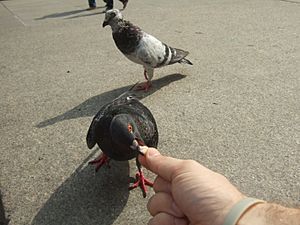
A better way to reduce the number of feral pigeons is to take away their food. Cities around the world have found that if people stop feeding their local birds, the pigeon population slowly goes down in a few years. Pigeons are scavengers, so they will still pick at garbage bags with food or leftovers dropped on the ground. But if food waste is put away securely, it will greatly reduce the number of pigeons. For example, feeding pigeons is not allowed in parts of Venice, Italy.
Dummy Egg Nesting Programs
Some cities have tried dummy egg nesting programs. In these programs, real pigeon eggs are removed from nests and replaced with fake eggs. The real eggs are then destroyed. If eggs are removed from nests too often, pigeons will try to lay new eggs sooner. This makes the method less effective. One such structure in Batman Park in Melbourne, Australia, did not attract pigeons and was later removed.
Counting Pigeon Populations
Counting how many pigeons there are is important for managing them in parks and cities. Here are some ways to estimate pigeon numbers:
- Stratified grids: This method divides an area into large squares (like 500x500 meters). Then, some squares are chosen randomly. Pigeons are counted within a 5-meter circle for 5 minutes in those chosen squares.
- Point-counts: An observer stands in the middle of a park. They turn 360 degrees while counting pigeons with a hand counter. They count pigeons within about 50 meters, limited by streets and buildings.
- Panoramas: This method involves taking 360-degree panoramic photos from the center of the park. Then, special software is used to count the pigeons in the photos. This method has been shown to be the most effective.



